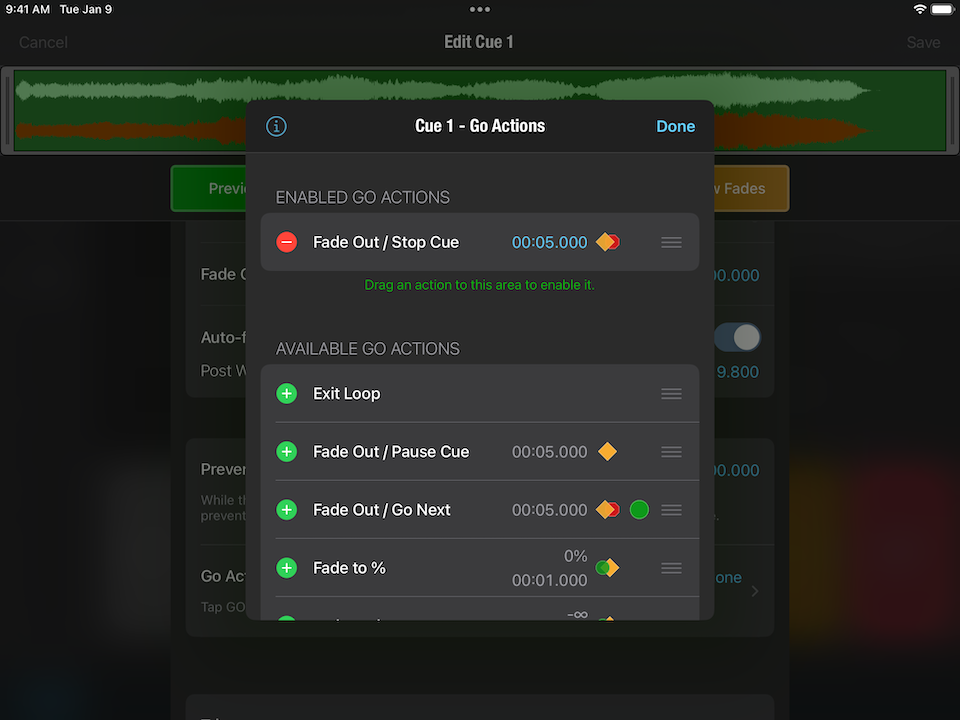
because the QLab workspace was closed) and some other issue with the network connection. This new delegate method now makes it possible for a client app to distinguish between the QLab workspace proactively notifying the client it should disconnect (e.g. This replaces the previous behavior in which clientConnectionErrorOccurred was called.
workspaceDisconnected (required) which is now called when a QLKClient receives an OSC /update/workspace//disconnect message from QLab. However, be aware that custom implementations of GCDAsyncSocketDelegate or GCDAsyncUdpSocketDelegate methods in any subclasses of QLKClient or F53OSCClient will now be called on a background thread and must dispatch back to the main thread when necessary. F53OSCClient ensures that its F53OSCClientDelegate methods continue to be called on the main thread. The internal F53OSCClient used by QLKClient now performs its TCP/UDP communication with QLab on a background thread. calls from cue:valueForKey:block:) were not being processed. Fixes an issue where replies from individual OSC getter methods (i.e. Subclasses or categories can override the name property to define additional colors. The name property and the class method + now return an empty QLKColor object for undefined color names. Colors and colorspaces are now more consistent between iOS and macOS. The convenience property quaternion remains unchanged and gets/sets a GLKQuaternion struct, and the new convenience setter setQuaternion:tellQLab: also accepts a GLKQuaternion struct. When using propertyForKey: to get the quaternion of a Video or Fade cue, the value is no longer transformed to NSValue and is now returned as an array of NSNumbers (representing the X, Y, Z, and W components of the quaternion). Adds convenience getters isOverridden, isBroken, isTailingOut, and isPanicking which also take into account the property values of child cues in Group, Cue List, and Cue Cart cues. Fixes panicCue: so that the QLKOSCIsPanickingKey property is only updated when connected to QLab 4.0 or later (which is the minimum QLab version that supports the /isPanicking OSC method). Fixes the class method cueTypeIsAudio: so that it now correctly returns NO for the following cue types: Fade, Camera, Text/Titles. QLabKit 0.0.4 requires macOS 10.9+ or iOS 8.4+. Open QLabKit.xcodeproj and run the QLabKitDemo project to learn more. There is also working demo project that shows how you might hook all of this together to find servers on the network, show their workspaces, connect to a workspace, and finally fetch and display all the cues. 
The QLKBrowser class handles this for you like so:Ĭreate a browser object and give it a delegate that implements QLKBrowserDelegate protocol: This allows for the automatic discovery of all QLab machines on the same local network. You can get this in one of two ways: Automatic

The first thing you need to do is to get a QLKWorkspace instance to communicate with a single workspace from QLab. Read the headers of these primary classes for more usage information. There are other classes in QLabKit that these classes rely on that you need not worry about. A cue list cue is also represented as a cue

QLKCue - a simplified representation of a cue.
 QLKWorkspace - a single workspace on a server. QLKServer - represents an individual QLab server with a name, host, and port. QLKBrowser - automatically discover QLab instances on the network. There are four primary classes you will use for talking to QLab: Pod 'F53OSC', :git => '' pod 'QLabKit', :git => '' Classes
QLKWorkspace - a single workspace on a server. QLKServer - represents an individual QLab server with a name, host, and port. QLKBrowser - automatically discover QLab instances on the network. There are four primary classes you will use for talking to QLab: Pod 'F53OSC', :git => '' pod 'QLabKit', :git => '' Classes








 0 kommentar(er)
0 kommentar(er)
